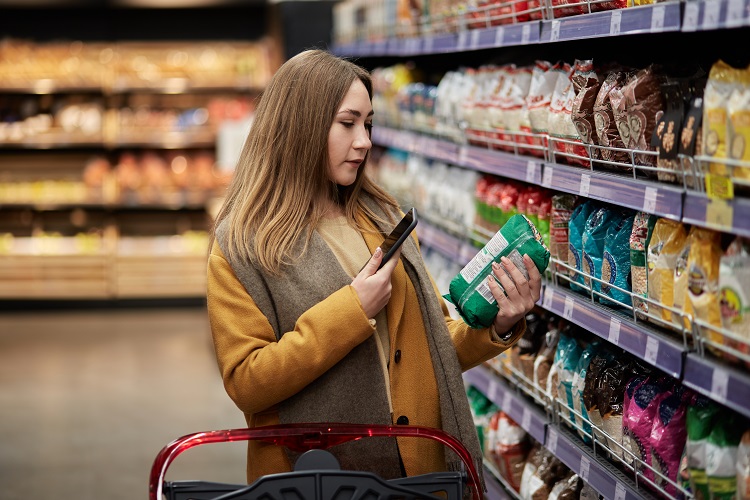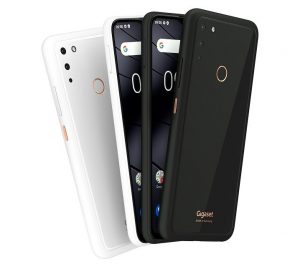 Source: iStock.com/Evgenia Tsvirko
Source: iStock.com/Evgenia Tsvirko
Smartphone in the supermarket: The best food scanner apps
2. November 2021 Published by Raphael DoerrSmartphone, smartphone in my hand, tell me more about this meat: What’s its background and country of origin? More and more people consult their smartphone while shopping in the supermarket to find out what foods are healthy, sustainable or animal-friendly.
Almost every one-in-two supermarket customer looks up a food’s origin and how it is produced before putting it in their shopping cart. According to a new survey by the digital association Bitkom, as healthy a diet as possible tops the rankings, with nine out of ten respondents saying it is a key purchasing criterion. The majority regard information about animal welfare (85 percent), sustainability (83 percent) and regional production (83 percent) as being important. The smartphone is increasingly used as the hub for obtaining such information. Food and product apps help customers make up their mind.
Consumers have a growing need for information when they buy food: on its ingredients, origin and how it is produced. The ingredients actually in products are important for 73 percent of respondents in choosing what to buy at the supermarket. Almost half (48 percent) of customers feel that transparency on a product’s origin and how it is produced are a relevant criterion before it ends up in their shopping cart. That’s the result of a representative survey of 1,007 people in Germany aged 16 and above, carried out on behalf of the digital association Bitkom.
Digital technologies are playing an ever greater role in satisfying the growing need for information. “People want to be informed when they make their way along the shelves and choose their products consciously. That constant companion, the smartphone, can provide quick and easy access to information,” explains Andreas Schweikert, Head of the Agriculture department at Bitkom.
The Nutri-Score alone is not enough for many people. According to the Bitkom survey, every one-in-four (24 percent) person uses barcode scanners on mobile devices directly in the supermarket to display details on a product’s origin and how it is made. Only one-in-five (20 percent) used that option back in 2019. 22 percent (2019: 19 percent) also obtained more information on what they were buying using a QR code. The Bitkom survey suggests that the percentage of people wanting to obtain information will likely continue to increase: 4 out of 10 (41 percent) can imagine using a barcode scanner and 35 percent a QR code.
There is growing interest in the issue of animal welfare in particular and so “consumers are increasingly demanding to know about the conditions in which animals are kept and food is produced. Digital technologies enable the trail to be followed right to the supermarket shelf,” emphasizes Bitkom’s expert Schweikert. It’s no longer enough for consumers to just be provided with the prescribed details on ingredients or the sell-by date. Many citizens expect further information, such as how the animals are kept or details about eco-friendly and fair production conditions.
Fair trade and protection of the environment
Protecting the climate and environment is a major concern for the surveyed persons in many areas. More respondents than last year – and across all age groups – want details of whether goods have been produced in an eco-friendly way (2020: 76%, 2021: 84%). There is also a somewhat greater desire for agriculture to use environmentally-friendly production methods compared to the previous year (an increase from 52% to 57%). 54 percent want emissions to be reduced. Opaque supply chains and a lack of information make it difficult for consumers to pick products that haven’t involved the tropical rainforest being chopped down or child labor being exploited. At the same time, more and more consumers are opting for organic and fair trade products so as not to support the negative consequences of food production. In addition, policymakers are trying to exert a steering influence on production by granting subsidies or enacting supply chain laws.
Where does that come from? What’s in it? Consumers want essential information on their food, as well as more transparency and easier access to product information. Several studies reveal four core expectations consumers have as regards their food:
- Product information on nutritional values and ingredients: There is a growing desire to find out as much as possible about the ingredients in and nutritional values of foods. A survey by Bitkom in 2020 revealed that most German consumers want precise information on what ingredients foods contain and how they are produced. 75% want to know exactly what’s in the food products they’re buying. 51% watch out for specific seals of quality or labels.
- In addition, the study by the DLG “My Food – Personalisierung und Ernährung” (“My Food – Personalization and Nutrition”) shows that 33% of respondents want to avoid certain ingredients in the food they eat. The reasons they cite for nevertheless not doing do are a lack of personalized nutritional advice and aids for dietary planning in everyday life. Food intolerances are also no rarity anymore; as a result, it’s more and more difficult for consumers to keep abreast in the supermarket about what ingredients and potential allergens are contained in what products.
- Product information on sustainability and fairness: According to a survey by forsa on behalf of vzbz, the Federation of German Consumer Organizations, 90% of those surveyed said it was “very” or “pretty difficult to see” whether food producers have obtained a fair price for their work and goods. The same applies to compliance with high environmental standards (that was not transparent to 87% of respondents).
Barcode scanner apps, QR codes and product apps
We wish to present a few of the most interesting apps here. Since we haven’t been able to test them ourselves, we refer to recent reporting in the media in discussing them.
The consumer app
“Yuka is a free mobile app for iOS and Android and is intended to give consumers an easier way of obtaining clear information on the ingredients and health impact of products by scanning the barcode. With the aid of a traffic light rating system, consumers can save themselves hours of tedious research of their own.” The independent consumer app Yuka helps shoppers decipher the labels on foods and cosmetic products so that their health impact can be assessed. Yuka now has more than 20 million users worldwide. Consumers scan everyday products in the Yuka app using the SDK barcode scanner from Scandit. The Yuka database now comprises a total of more than 1.5 million food and more than 500,000 cosmetic products. 800 products are added to the database every day.
Yuka uses a simple color code to inform you of the product’s impact on your health. The colors stand for excellent, good, mediocre, or poor.
Download: Android
The sustainability app
We should not only be concerned about our own health, but also that of others. The “Beat the Microbead” app shows which products contain microplastics and so are gradually polluting the world and ultimately pose a risk for us humans, too. The products are divided into four categories, in a traffic light system from red to green, in other words, from products containing a great deal of microplastics to very few, with the best category being “zero” – denoting products that are completely plastic-free.
The barcode scanner app
The barcode scanner app Barcoo is a compelling aid to achieving a more conscious and healthier diet. It has probably seldom been as easy to find out in seconds what foods are healthy and what you ought not touch – directly in the supermarket. Barcoo’s vendor claims it is the first product scanner app in Germany to have a food traffic light. It tells you at a glance the quantity of the most important health-related nutritional values contained in a product and how they can be rated from a health perspective. If, for example, a processed food is pumped full of sugar, you can see that right away from the red symbol. That means you should eat the product only in moderation – if at all. Apart from the food traffic light, the app delivers important information on sustainability aspects relating to individual brands and products. It’s therefore an ideal tool if you feel it important to buy sustainable, ethically correct and fair products. In addition, the app supplies its users with further interesting information on the ingredients of a scanned product, as well as whether it comes in misleading packaging, for example.
Download for Android
The CodeCheck app
The CodeCheck app can be used to find out which (harmful) ingredients are in cosmetic products, foods, cleaning agents and other consumer goods. The app advertises itself as “your shopping assistant for a conscious lifestyle” on the website and aims to give consumers transparency. Users can scan any desired product, including foods and cosmetics, with a bar scanner on their smartphone and are then shown a list of the ingredients. Their risk to people and the environment is shown along with them. When you’re shopping, CodeCheck can also display whether a product is vegan, vegetarian, lactose-free and gluten-free and whether it contains a lot of salt, fat and sugar. The app is therefore not only suitable for the health- and environmentally-conscious, but also for people with intolerances.
Climate Score for food
CodeCheck developed the new feature Climate Score together with the Eaternity Institute in November 2020. It can be used to display the CO2 footprint of foods from the supermarket in the app. That means you can see at any time what impact your own diet has on the climate and where you can reduce it. The Climate Score shows how many CO2 equivalents a food causes compared to all other listed foods. The scores awarded are “very good,” “good” or “critical”, and the nutritional value is taken into account to enable better comparison between foods.
You can find more apps at: https://utopia.de/ratgeber/die-besten-gruenen-oeko-apps/
The smartphone for shopping in the supermarket
So that your smartphone’s battery does not suddenly run out of juice while you’re checking food in the supermarket, you’re advised to use a powerful phone like the Gigaset GS4. The durable battery has a talk time of up to 25 hours in the 3G/4G network. That’s enough to subject all foods to a thorough check. The camera system of the Gigaset GS4 consists of a 16-MP camera for pin-sharp product photos in any lighting conditions. Apart from the 5-MP wide-angle camera, it also boasts the advantage of a 2-MP macro camera that can also present the smallest of things in large.
 Comments
Comments

 en
en 







